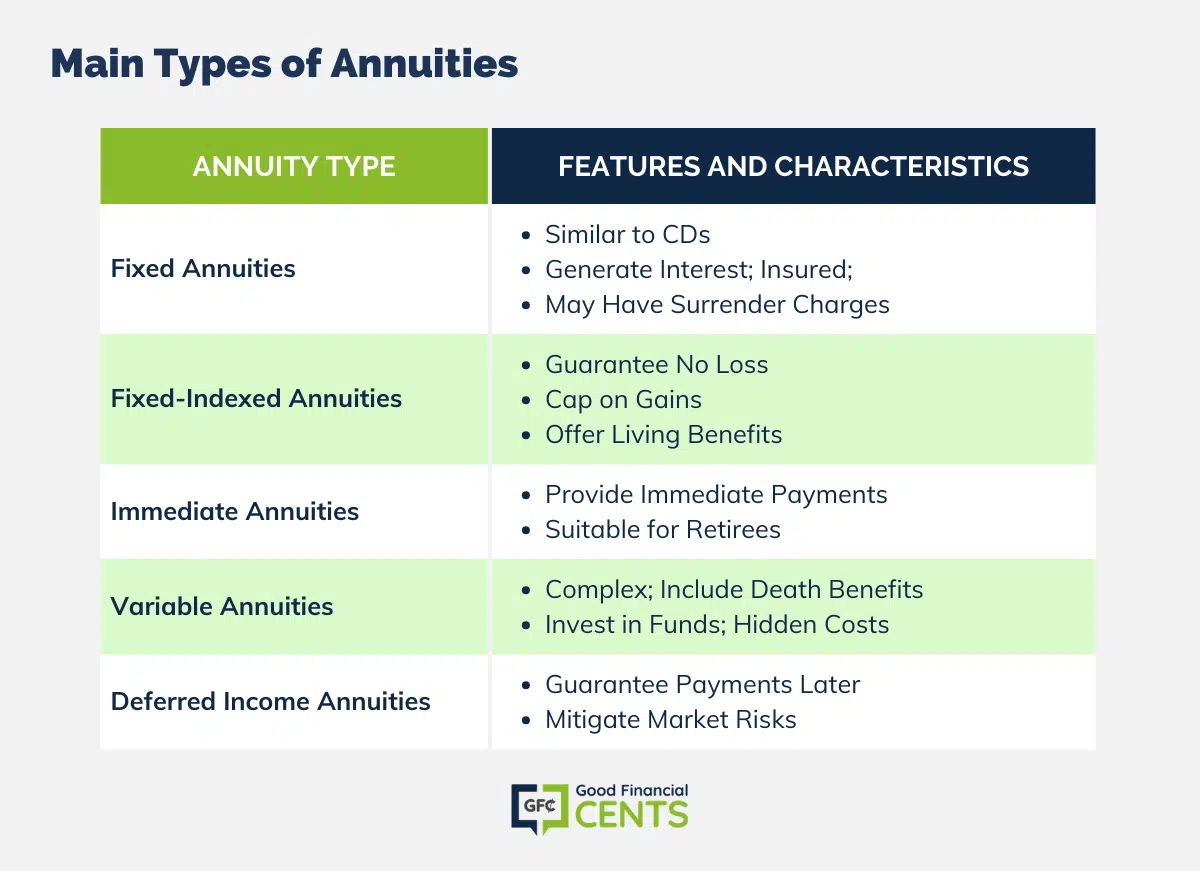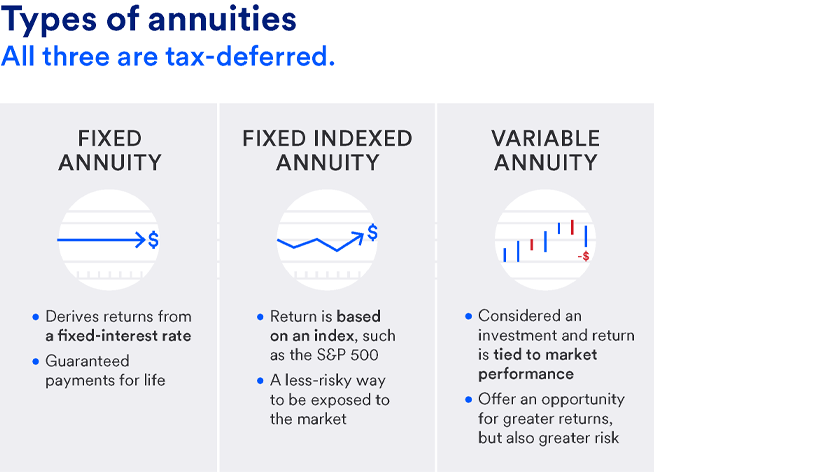All Categories
Featured
Table of Contents
The payment could be spent for growth for a long duration of timea solitary premium delayed annuityor spent momentarily, after which payment beginsa solitary premium immediate annuity. Solitary premium annuities are frequently moneyed by rollovers or from the sale of a valued property. A flexible costs annuity is an annuity that is intended to be moneyed by a collection of repayments.
Proprietors of repaired annuities know at the time of their acquisition what the worth of the future capital will be that are generated by the annuity. Certainly, the variety of capital can not be understood in advance (as this relies on the contract proprietor's lifespan), yet the assured, dealt with rate of interest at least provides the owner some level of certainty of future revenue from the annuity.
While this distinction seems straightforward and simple, it can significantly impact the worth that a contract owner ultimately derives from his or her annuity, and it creates substantial unpredictability for the agreement proprietor - Benefits of annuitization. It additionally typically has a material effect on the degree of costs that an agreement owner pays to the issuing insurance firm
Fixed annuities are typically used by older financiers that have restricted possessions but that intend to offset the risk of outliving their possessions. Set annuities can serve as an effective device for this function, though not without particular downsides. In the case of immediate annuities, when an agreement has been bought, the agreement proprietor relinquishes any and all control over the annuity properties.
Exploring the Basics of Retirement Options Everything You Need to Know About Immediate Fixed Annuity Vs Variable Annuity What Is Fixed Vs Variable Annuity Pros Cons? Features of Smart Investment Choices Why Choosing the Right Financial Strategy Is Worth Considering How to Compare Different Investment Plans: How It Works Key Differences Between Different Financial Strategies Understanding the Rewards of Fixed Indexed Annuity Vs Market-variable Annuity Who Should Consider Strategic Financial Planning? Tips for Choosing the Best Investment Strategy FAQs About Fixed Indexed Annuity Vs Market-variable Annuity Common Mistakes to Avoid When Planning Your Retirement Financial Planning Simplified: Understanding Your Options A Beginner’s Guide to Smart Investment Decisions A Closer Look at Pros And Cons Of Fixed Annuity And Variable Annuity
A contract with a regular 10-year surrender duration would certainly charge a 10% abandonment cost if the agreement was given up in the first year, a 9% abandonment cost in the second year, and so on until the abandonment charge gets to 0% in the contract's 11th year. Some deferred annuity contracts consist of language that permits small withdrawals to be made at various periods throughout the surrender duration without charge, though these allocations typically come with a price in the kind of lower guaranteed passion prices.
Simply as with a fixed annuity, the owner of a variable annuity pays an insurer a round figure or collection of repayments for the assurance of a series of future repayments in return. Yet as mentioned over, while a dealt with annuity grows at an assured, consistent rate, a variable annuity grows at a variable rate that depends upon the efficiency of the underlying investments, called sub-accounts.
Throughout the accumulation phase, properties bought variable annuity sub-accounts grow on a tax-deferred basis and are tired just when the contract owner takes out those profits from the account. After the build-up phase comes the income phase. Over time, variable annuity possessions need to in theory boost in value up until the contract proprietor chooses she or he wish to start withdrawing cash from the account.
One of the most significant concern that variable annuities commonly existing is high expense. Variable annuities have several layers of fees and expenditures that can, in accumulation, produce a drag of as much as 3-4% of the agreement's worth each year. Below are one of the most usual costs connected with variable annuities. This expenditure makes up the insurance company for the threat that it thinks under the regards to the contract.
M&E cost costs are computed as a portion of the agreement value Annuity providers pass on recordkeeping and various other administrative prices to the contract proprietor. This can be in the kind of a flat yearly cost or a portion of the contract value. Management fees might be consisted of as part of the M&E risk cost or may be assessed individually.
These fees can vary from 0.1% for passive funds to 1.5% or more for actively handled funds. Annuity contracts can be personalized in a variety of means to serve the particular demands of the agreement owner. Some common variable annuity bikers include ensured minimal buildup advantage (GMAB), guaranteed minimum withdrawal benefit (GMWB), and ensured minimal revenue benefit (GMIB).
Understanding Fixed Annuity Vs Equity-linked Variable Annuity A Comprehensive Guide to Investment Choices What Is the Best Retirement Option? Benefits of What Is Variable Annuity Vs Fixed Annuity Why Choosing the Right Financial Strategy Is a Smart Choice How to Compare Different Investment Plans: Simplified Key Differences Between Different Financial Strategies Understanding the Rewards of Long-Term Investments Who Should Consider Strategic Financial Planning? Tips for Choosing Fixed Annuity Vs Variable Annuity FAQs About Fixed Annuity Vs Equity-linked Variable Annuity Common Mistakes to Avoid When Planning Your Retirement Financial Planning Simplified: Understanding Fixed Vs Variable Annuity Pros And Cons A Beginner’s Guide to What Is A Variable Annuity Vs A Fixed Annuity A Closer Look at Tax Benefits Of Fixed Vs Variable Annuities
Variable annuity contributions give no such tax deduction. Variable annuities often tend to be very ineffective vehicles for passing wide range to the future generation because they do not enjoy a cost-basis modification when the initial agreement proprietor dies. When the proprietor of a taxed financial investment account dies, the price bases of the investments held in the account are changed to show the marketplace prices of those investments at the time of the proprietor's death.
Such is not the instance with variable annuities. Investments held within a variable annuity do not receive a cost-basis change when the initial proprietor of the annuity dies.

One substantial concern connected to variable annuities is the possibility for disputes of passion that may feed on the part of annuity salespeople. Unlike a financial advisor, who has a fiduciary task to make financial investment decisions that profit the customer, an insurance policy broker has no such fiduciary obligation. Annuity sales are very rewarding for the insurance policy specialists who offer them as a result of high upfront sales commissions.
Several variable annuity agreements consist of language which places a cap on the percentage of gain that can be experienced by certain sub-accounts. These caps prevent the annuity proprietor from fully taking part in a portion of gains that could otherwise be appreciated in years in which markets produce considerable returns. From an outsider's perspective, it would appear that investors are trading a cap on financial investment returns for the abovementioned assured flooring on financial investment returns.
Breaking Down Pros And Cons Of Fixed Annuity And Variable Annuity Everything You Need to Know About Fixed Vs Variable Annuity Pros And Cons What Is the Best Retirement Option? Features of Immediate Fixed Annuity Vs Variable Annuity Why Choosing the Right Financial Strategy Is a Smart Choice How to Compare Different Investment Plans: How It Works Key Differences Between Different Financial Strategies Understanding the Risks of Deferred Annuity Vs Variable Annuity Who Should Consider Strategic Financial Planning? Tips for Choosing the Best Investment Strategy FAQs About Immediate Fixed Annuity Vs Variable Annuity Common Mistakes to Avoid When Choosing Indexed Annuity Vs Fixed Annuity Financial Planning Simplified: Understanding Your Options A Beginner’s Guide to Smart Investment Decisions A Closer Look at How to Build a Retirement Plan
As noted over, give up fees can drastically restrict an annuity proprietor's capability to relocate assets out of an annuity in the very early years of the contract. Further, while the majority of variable annuities allow contract proprietors to withdraw a defined amount throughout the buildup stage, withdrawals yet amount commonly lead to a company-imposed fee.
Withdrawals made from a fixed rate of interest financial investment alternative can also experience a "market value adjustment" or MVA. An MVA changes the value of the withdrawal to reflect any type of adjustments in rates of interest from the time that the cash was invested in the fixed-rate option to the moment that it was taken out.

On a regular basis, also the salesmen that offer them do not totally comprehend exactly how they function, therefore salesmen sometimes take advantage of a customer's feelings to market variable annuities instead of the benefits and viability of the products themselves. Our team believe that capitalists need to fully recognize what they have and exactly how much they are paying to have it.
The exact same can not be claimed for variable annuity assets held in fixed-rate financial investments. These possessions lawfully belong to the insurance provider and would certainly consequently go to danger if the firm were to fail. Any kind of guarantees that the insurance coverage company has actually concurred to supply, such as an assured minimal revenue advantage, would certainly be in concern in the occasion of a business failure.
Decoding How Investment Plans Work Everything You Need to Know About Fixed Annuity Or Variable Annuity What Is Fixed Indexed Annuity Vs Market-variable Annuity? Advantages and Disadvantages of Different Retirement Plans Why Choosing the Right Financial Strategy Matters for Retirement Planning Pros And Cons Of Fixed Annuity And Variable Annuity: How It Works Key Differences Between Variable Vs Fixed Annuity Understanding the Key Features of Fixed Income Annuity Vs Variable Annuity Who Should Consider Fixed Vs Variable Annuity Pros And Cons? Tips for Choosing the Best Investment Strategy FAQs About Fixed Income Annuity Vs Variable Growth Annuity Common Mistakes to Avoid When Planning Your Retirement Financial Planning Simplified: Understanding Retirement Income Fixed Vs Variable Annuity A Beginner’s Guide to Smart Investment Decisions A Closer Look at How to Build a Retirement Plan
Possible buyers of variable annuities need to recognize and consider the monetary condition of the releasing insurance company before getting in into an annuity agreement. While the benefits and downsides of various kinds of annuities can be questioned, the real issue bordering annuities is that of viability. In other words, the question is: that should have a variable annuity? This inquiry can be tough to address, provided the myriad variations offered in the variable annuity world, yet there are some basic standards that can help investors choose whether or not annuities must contribute in their monetary strategies.
As the saying goes: "Customer beware!" This write-up is prepared by Pekin Hardy Strauss, Inc. ("Pekin Hardy," dba Pekin Hardy Strauss Wide Range Management) for educational purposes just and is not intended as an offer or solicitation for company. The details and data in this write-up does not constitute legal, tax, bookkeeping, financial investment, or various other expert advice.
Table of Contents
Latest Posts
Understanding Fixed Vs Variable Annuity Everything You Need to Know About Financial Strategies Defining the Right Financial Strategy Features of Indexed Annuity Vs Fixed Annuity Why Fixed Index Annuit
Breaking Down Fixed Income Annuity Vs Variable Growth Annuity A Comprehensive Guide to Fixed Interest Annuity Vs Variable Investment Annuity Defining Fixed Index Annuity Vs Variable Annuity Benefits o
Breaking Down Your Investment Choices Key Insights on Your Financial Future Breaking Down the Basics of Fixed Interest Annuity Vs Variable Investment Annuity Advantages and Disadvantages of Different
More
Latest Posts